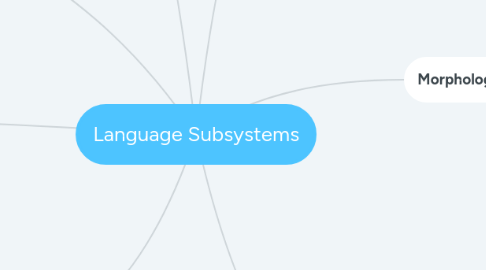
1. Syntax
1.1. How words form sentences to construct meaning
1.1.1. Clauses
1.1.1.1. Independent
1.1.1.1.1. Can stand alone in a sentence and make sense
1.1.1.2. Dependent
1.1.1.2.1. Depends of another clause to make sense in a sentence
1.1.2. Types of sentences
1.1.2.1. A simple sentence
1.1.2.1.1. One independent clause
1.1.2.2. A compound sentence
1.1.2.2.1. Two independent clauses joined with a coordinator
1.1.2.3. A complex sentence
1.1.2.3.1. One independent and one dependent clause joined with a subordinator
1.1.2.4. A compound- complex sentence
1.1.2.4.1. One of more of each type of clause
1.2. Example
1.2.1. For dinner ate we fish/ We ate fish for dinner
2. Discourse
2.1. How sentences are combined in text either spoken or written
2.2. Example
2.2.1. When the architects of our republic wrote the magnificent words of the Constitution and the Declaration of Independence, they were signing a promissory note to which every American was to fall heir. This note was a promise that all men, yes, black men as well as white men, would be guaranteed the "unalienable Rights" of "Life, Liberty and the pursuit of Happiness." It is obvious today that America has defaulted on this promissory note, insofar as her citizens of color are concerned. Instead of honoring this sacred obligation, America has given the Negro people a bad check, a check which has come back marked "insufficient funds."
3. Semantics
3.1. Meanings
3.1.1. Types of meaning
3.1.1.1. Denotative meaning
3.1.1.1.1. The meaning that you find in the dictionary
3.1.1.2. Connotation
3.1.1.2.1. Is the meaning that a word takes on by how people use it
3.2. Example
3.2.1. White lie
4. Phonology
4.1. How sounds are organised
4.2. Example
4.2.1. boy (boɪ).
5. Phonetics
5.1. The study of sounds themselves
5.1.1. Prosodic Features
5.1.1.1. Properties that we use when we pronounce groups of sounds
5.1.1.1.1. Timing
5.1.1.1.2. Loudness
5.1.1.1.3. Pitch
5.1.1.1.4. Stress
5.2. How we produce the sounds
5.3. Examples
5.3.1. ʊ: put, could
5.3.2. æ: cat, black
5.3.3. eɪ: say, eight
6. Morphology
6.1. Formation and structure of words
6.1.1. Morpheme
6.1.1.1. Is the smallest meaningful unit of speech
6.1.1.1.1. Types of morphemes
6.2. Example
6.2.1. Bathroom (free morphemes)
7. Lexicology
7.1. Study and categorisation of words
7.1.1. Words are grouped into classes
7.1.1.1. Nouns and noun phrases
7.1.1.1.1. Can be things, people, physical objects, etc. In noun phrases, the function of the noun as subjects or objects.
7.1.1.2. Verbs and verb phrases
7.1.1.2.1. Verbs are actions, can also show process, states or events.
7.1.1.3. Auxiliaries
7.1.1.3.1. An auxiliary is a helping verb
7.1.1.4. Adjectives
7.1.1.4.1. Describe properties or states of nouns or noun phrases
7.1.1.5. Adverbs
7.1.1.5.1. Modify or describe words, adjectives or other adverbs
7.1.1.6. Conjuctions
7.1.1.6.1. Link clouses or sentences together
7.1.1.7. Determiners
7.1.1.7.1. Determines the amount of a noun or noun phrase
7.2. Examples
7.2.1. Slowly, sadly (Adverbs)
